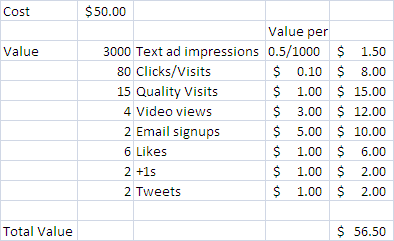What Is The Real Value Of Branded Search Campaigns?
Enterprise SEM practices apply not just to direct response advertisers, but to brand advertisers as well. We’ll dive into that logic after a brief stroll down memory lane. The earliest adopters of sophisticated paid search practices were those companies with deep roots in direct response marketing. In e-commerce, it was the traditional catalog companies that […]
Enterprise SEM practices apply not just to direct response advertisers, but to brand advertisers as well. We’ll dive into that logic after a brief stroll down memory lane.
The earliest adopters of sophisticated paid search practices were those companies with deep roots in direct response marketing.

Roots in Direct Response Marketing
In e-commerce, it was the traditional catalog companies that figured out search first. The cost of a book (catalogs are called “books” by insiders) in the mail looked a lot like the cost of a click, and conversion rates looked a great deal like catalog response rates.
Catalogers were steeped in notions of segmenting data by source, by geography, by season, by interaction history, as well as creative and offer testing. They were also comfortable driving by that information.
In finance, it was the credit card companies who were quickest to understand the connection to direct mail and applied the same intellectual rigor that served them in those pursuits. Internet pure plays that grew up in tracked marketing were quick adopters as well.
Many well-established companies that relied historically on TV, newspaper circulars, radio and other media buys that are inherently less trackable were generally slower to adapt to advanced SEM practices, because driving marketing decisions by the numbers wasn’t deeply ingrained in their culture.
(Note: I’m casting no aspersions on the brands below as I don’t know how they’ve driven their programs, just giving samples of the types of companies I’m talking about.)

Roots in Media Buying Not DR
Big Box retailers, banks, clothiers, real estate brokerages and others often still make the mistake of thinking of paid search the same way they think about print ads: impressions, audiences, context and creative.
We often find horrendously broken programs, spending money with no rhyme or reason as to how the money is spent. Mismanagement of the critical non-brand spend is often hidden by brand advertising performance.
In many, many of these cases the objective may be brand building. In other cases like those below, building brand awareness is the only realistic objective.

Purely Brand Building
Where sales are widely distributed and untrackable (Budweiser, Levi Strauss, Ford, Blistex, Paramount, the Florida tourist bureau), or not the objective at all (a presidential campaign, Exxon, BASF), branding is the right way to advertise.
But if brand advertising is the objective, there is no reason the same paid search rigor won’t prove useful. Simply spending a budget, targeted at a blanket Cost per thousand impression (“CPM”) or targeted to capture a certain “impression-share” is not the way to get the most bang for the buck.
How Should Value Be Determined For A Branded Campaign?
For a brand building program, careful consideration should be given to how value is determined. I’ve heard people compare the CPMs available in search or display to print or TV and thought: huh? Talk about comparing apples to oranges!!!
The cost of the impressions may be similar, but what about the value of the impression to the brand? Certainly watching a 30 second TV spot has a different impact on a person than does a text ad that appears on a webpage along with 20 other text blocks.
The human user searching for something relevant to your brand is far more valuable than the regionally/demographically targeted TV viewer (who may be getting a snack during your spot), but the impression itself conveys much less about your brand.
Paid search is managed well when the cost of advertising is married to the value of the advertising. We must first consider carefully the value associated with different types of brand interactions.
A paid search ad may have a very well understood and easily measured cost, let’s say $50 for a day, but what you get for that cost may be a complex set of brand interactions that look like this:
How do we make sense of that value?
The best approach is to create some sort of common value metric hopefully based on data, but minimally based on good intuitive reasoning. It might look like this:
Now, this is a bit idealized, but you get the notion. In this case, the value appears to be worth the costs and that ad can bear a CPC of $0.63. Text ads with similar numbers of impressions may have dramatically more or less value based on the quality of interaction after the exposure. Evaluating by CPM is the wrong way to think about this.
The complexities don’t stop there. For State Farm, Century 21, or Talbots, shouldn’t the brand advertising be more valuable in close proximity to the brick and mortar presence, where dropping by the store or office may become more top of mind and more likely?
Shouldn’t we place even more branding value on traffic coming from mobile devices near the physical locations? Maybe smart phones > tablets > desktop?
If there is more valuable brand advertising available than you’ve budgeted for, how should we prioritize? We may find that we can spend the whole branding budget on very tightly aligned keywords.
Is it better in this case to spend the whole budget on the highly targeted tail, or on a handful of head terms that are less well targeted to your brand?
If you’re the Romney campaign, for example – which type of keyword would you spend the most money on: “Obamacare”, “Health Insurance Reform Act”, or “Health care policy debate”?
During the primary, you may want to appeal to the base more than others and focus on people searching for Obamacare. During the presidential campaign, maybe you don’t need to advertise as much to them, but really want to hammer the “Health care policy debate” searchers on Google, Bing, and YouTube.
The point is simply this: driving brand advertising dollars ‘by the numbers’ pays dividends just as it does with direct response. The complexities of brand value measurement make applying this rigor more challenging, but every bit as worthwhile.
Opinions expressed in this article are those of the guest author and not necessarily Search Engine Land. Staff authors are listed here.
Related stories
New on Search Engine Land

